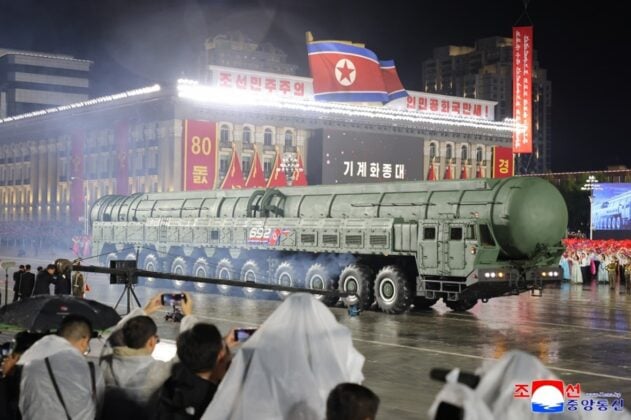
At a military parade marking the 80th anniversary of the ruling Workers’ Party, North Korea drove a formation of its newest intercontinental ballistic missile, the Hwasong-20, past the reviewing stand, in what state coverage described as a new step in the country’s strategic forces.
According to official coverage, the Hwasong-20 is a next-generation ICBM with a larger diameter and greater thrust than earlier designs.
The missile was shown mounted on an 11-axle, 22-wheel wheeled transport, erection and launch chassis — a high-mobility, off-road platform that combines transport, raising and launch functions. State reporting noted that the Hwasong-20 uses a new solid-fuel motor whose first stage has a larger diameter and markedly increased propellant capacity.
Those design choices, the report said, directly increase the missile’s thrust and payload capacity. The parade visuals and the official account suggest Pyongyang is pursuing either multiple independently targetable reentry vehicles or a higher-yield single warhead to expand its strategic reach. The reporting contrasted the Hwasong-20 with the earlier Hwasong-19, saying that while the Hwasong-19 had sufficient range to reach the continental United States, its deterrent value was limited by a single warhead that lacked the same destructive power. The state narrative presented the Hwasong-20 as a response to that limitation, intended to “further raise the practical effect of strategic deterrence against the United States” by fielding multiple warheads or a more powerful single warhead.
North Korea’s missile development has followed a pattern of rapid, small-step iterations in recent years. The official account set the Hwasong-20 in a lineage that includes Hwasong-14 through Hwasong-18, noting a process of steady refinement and learning through successive models. As the report said, that approach of “small steps, fast runs” has allowed Pyongyang to amass technical experience and gradually improve missile performance.
A highly mobile transporter-erector-launcher can complicate an adversary’s targeting and make a missile force harder to suppress. Solid propellant reduces launch preparation time compared with liquid-fueled designs, allowing faster reaction and greater survivability in a crisis. The combination of mobility and quick-reaction fueling is therefore central to the operational concept promoted in the official material.
The parade provided visual evidence of the system’s size and chassis, but published material did not include technical performance data such as throw-weight, range with a full multiple warhead load, or reentry vehicle characteristics. Those details will determine whether the weapon materially alters strategic balances or is primarily a signaling tool.